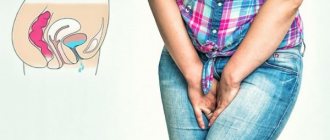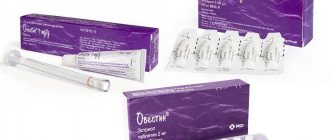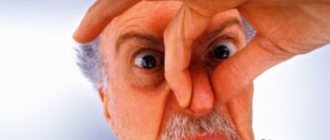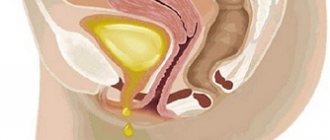Types of urinary incontinence in older people
Pathology is divided into main types:
- stress incontinence – caused by physical exertion. This could be lifting weights, laughing, coughing and others. As a result of the resulting tension, urine begins to flow uncontrollably. The reason is the weakening of the pelvic floor muscles caused by age-related changes,
- Urgent incontinence - associated with the influence of certain elements of the external environment that provoke the urge to urinate, for example, the sound of pouring water from a tap or the babbling of a stream,
- transient incontinence – manifests itself against the background of diseases of the urinary system of an infectious-inflammatory nature,
- overflow is considered a rare occurrence. This type of incontinence is more typical for men than for women, since it is caused by hyperplasia of prostate adenoma, the structure of the urethra, oncology,
- mixed type of incontinence - its characteristic feature is the simultaneous manifestation of all types of involuntary urine output.
Types
There are several types of urinary incontinence. With the same result, the causes of the disease may be different.
Stressful
Stress urinary incontinence occurs due to pelvic floor insufficiency. It occurs when there is injury or damage to the tissues of the pelvic floor or perineum. In this case, the walls of the vagina shift, and the position of the uterus and bladder is disrupted.
Stress urinary incontinence is both a sign, a symptom and a condition.
- Sign. Urine is released involuntarily and immediately after abdominal pressure increases (coughing, sneezing)
- State. The release of urine is involuntary, it is associated with the excess of intravesical pressure over the maximum urethral pressure, while the detrusor is not active.
- Symptom. Urine begins to leak during physical activity.
Temporary
Temporary urinary incontinence is a pathology that occurs while taking certain medications, drinks or other temporary factors. You can get rid of it by changing your lifestyle and diet.
Causes of temporary urinary incontinence:
- Excess fluid in the body. If you consume a large amount of liquid in a short period, you may accidentally urinate. This can happen, for example, during an abdominal ultrasound, during which the bladder should be as full as possible.
- Alcohol. Drinking alcoholic beverages in large quantities can cause involuntary and uncontrollable urination, since alcohol promotes rapid filling of the bladder (especially beer).
- Dehydration. If you do not drink enough fluid, the urine becomes concentrated and can cause irritation of the bladder and immediate urination.
- Medicines. Antidepressants, diuretics, and muscle relaxants can cause an uncontrollable urge to urinate. Some cold and hypertension medications also have this side effect.
- Anesthesia. In some cases, urinary incontinence may be a consequence of anesthesia during surgery.
Urgentnoe
Urgent is a condition in which the patient experiences a sudden urge to urinate, but cannot tolerate it. Also, if urine leakage occurs against the background of the urge to urinate.
This pathology most often occurs with age, and in most cases it affects males. The patient cannot be away from a place where he can go to the toilet for a long time. This significantly limits his movement, performance and sexual contacts.
An urgent state is characterized by the loss of a large volume of urine during an imperative urge. This indicates an overactive bladder.
Causes of urgent condition:
- Damage to the brain or spinal cord due to injury or disease.
- Infectious diseases of the genitourinary system (prostatitis, cystitis).
- Neoplasms in the bladder.
- Benign or malignant prostate tumor.
- In some cases, the cause of urinary incontinence cannot be determined.
Mixed
The mixed form of urinary incontinence most often affects women from thirty to seventy years of age. It combines urge and stress incontinence. The disease progresses with age. In most cases, it is caused by progressive estrogen deficiency.
When atrophic processes occur in the urothelium, the vascularization of the wall of the urethra becomes weaker and the collagen content of the connective tissue decreases.
Also, the cause of the disease can be a difficult birth, during which there were injuries and ruptures of the perineum.
Paradoxical
With paradoxical urinary incontinence, the patient is unable to urinate for a certain period of time. As a result, chronic urinary retention occurs and the bladder itself stretches.
The tone of the muscle walls is too weak and it is not possible to expel the contents of the bladder. Arriving from the kidneys, urine does not fit and involuntarily oozes through the urethra in drops.
This standing is called paradoxical because the patient experiences both incontinence and urinary retention.
Causes and risk factors
Everyone is at risk of developing incontinence in old age. It is due to the following factors:
- certain physiological age-related changes. For example, over the years, the volume of the bladder decreases, in women this is the onset of menopause,
- disruption of brain activity,
- hormonal changes. They significantly weaken the muscles of the urinary system,
- damage to the integrity of the mucous membrane of the genitourinary system,
- using certain medications
- polyuria (increased production of urine),
- inflammatory processes in the urinary tract,
- prostate diseases,
- the occurrence of edema,
- partial or complete restriction of a person’s mobility resulting from a certain type of disease,
- hard work throughout life,
- overweight,
- constipation This reason applies more to bedridden and sedentary patients and patients with mental disorders.
The following reasons influence the development of uncontrolled urinary incontinence in the future:
- gender It is reliably known that women are more often exposed to this pathology than men,
- individual structure of organs,
- pregnancy and labor often cause prolapse of the uterus and bladder,
- surgical operations performed on the prostate gland,
- obesity,
- neurological diseases affecting brain functions such as stroke, multiple sclerosis and others,
- nutrition. The predominance of foods containing acids in the daily consumption has a negative (irritating) effect on the mucous membrane of the bladder and can provoke pathology over time,
- bad habits (smoking, alcohol, drugs),
- genetic predisposition,
- damage to organs located in the abdominal cavity,
- race. It is believed that people with white skin are more prone to incontinence than representatives of other races.
Classification
Classification of pathology helps determine its type and prescribe the correct treatment. Urinary incontinence is classified as follows:
| Type | The location of the bottom of the urinary bladder (bladder at rest) relative to the upper edge of the symphysis pubis | How urine is excreted |
| 0 | Higher | Urine does not leak |
| 1 | Higher | If a person pushes, the bottom of the bladder drops by about one centimeter and the urethra and bladder neck open up. Urine begins to leak |
| 2a | At the level | When a cough occurs, the urethra and bladder descend lower, the urethra opens wide and urine is released. |
| 2b | Below | When you cough, the bladder drops significantly and urine is released. |
| 3 | Below | The proximal urethra and bladder neck are slightly open at rest. Urine begins to be released when the pressure inside the bladder increases slightly. |
| 3a | Below | The lesion of the dislocation of the urethrovesical segment and the sphincter apparatus is combined. |
False urinary incontinence
The cause of false urinary incontinence is a congenital or acquired defect of the bladder or urinary tract:
- Epispadias of the bladder.
- Bladder exstrophy.
- Abnormal location of the ureteric orifices.
False urinary incontinence is almost always associated with injuries: surgical, birth or domestic.
True urinary incontinence
This pathology is characterized by the fact that the patient’s bladder integrity is not compromised, but urine may leak out involuntarily. This pathology is permanent and does not depend on the position of the patient’s body, his mental or physical state.
Also, true urinary incontinence can occur in the event of physical exertion, increased abdominal pressure or coughing.
In some cases, true urinary incontinence can only occur during sleep, this occurs due to the loss of control of the cerebral hemispheres over the sphincters.
Characteristic features of incontinence in women
More than half of older women experience urinary incontinence. According to the observations of doctors, most cases of uncontrolled urine leakage occur due to stress incontinence, it is about 40-20% - this is an urgent form of pathology, mixed types - about 60%. Sources causing the problem:
- changes in hormonal balance associated with physiological changes in the body, resulting in a decrease in the number of female sex hormones,
- weakening of the muscles of the abdominal region,
- changes in bladder muscle tone caused by stress, abnormalities in the functioning of the nervous system, impaired blood circulation, especially in the brain, neurodegenerative diseases (Parkinson’s disease, Alzheimer’s and others),
- inflammation of the reproductive system,
- surgical intervention.
When do problems start?
The problem of urinary incontinence most often appears after childbirth in women. But if after the birth of the child everything was normal, then you can expect this symptom to appear at 50-70 years of age.
In men, involuntary urination also appears by the age of 60-70 years. Most often this is associated with prostate diseases, but can also be caused by diseases of the nervous system.
The risk of urinary incontinence is higher in those older people who are subject to frequent hospitalization. 7 out of 10 people who end up in nursing homes have this problem.
Diagnostic procedures
If you have a problem like urinary incontinence, you should consult a doctor. In most cases, incontinence in older people is completely curable. The specialist determines the cause that causes failures in the mechanism of regulation of urine containment and excretion, and prescribes appropriate therapy.
To determine the origin of the pathology, the following examination methods are used:
- medical examination of the patient,
- obtaining the necessary information about the state of a person’s health in order to identify the reasons that provoked the leakage of urine,
- ultrasound examination of the abdominal organs,
- Functional examination of the lower urinary tract is a comprehensive urodynamic study that allows you to evaluate urinary function. To do this, diagnostic procedures are carried out: cystometry (diagnosis of bladder diseases and assessment of its functions), uroflocmetry (method for determining failures in the process of urine excretion), profilometry (obtaining a graphic image of the pelvic organs).
- PAD test - determines the amount of urine excreted in women,
- general urinalysis – gives an idea of existing diseases of the urinary system,
- bacteriological culture of urine - shows the presence of pathogenic microorganisms in it,
- cystoscopy of the bladder.
Experts advise people suffering from urinary incontinence to keep a diary where they record data about the fluid they drink and excrete. Records should be kept for 5-7 days.
Diagnostic measures
In order to make a correct diagnosis and prescribe appropriate treatment, it is important for the doctor to know: what lifestyle the patient leads, how much fluid he consumes per day. The history of urinary incontinence in elderly men is studied, at what hours of the day or night involuntary urination is observed and what is the frequency per day, the strength of the urine flow.
Conducted:
Diagnostic measures
- urodynamic tests to check the working condition of the urethra and bladder;
- urine analysis to identify composition, possible bacterial damage;
- cystometry to identify quantitative indicators of urine, pressure in the bladder cavity when filled with urine;
- uroflowmetry to determine the degree of bladder function;
- electronic tests to measure urine flow rate;
- cystoscopy or urethrocystoscopy by identifying problems in the lower genitourinary tract, urethra and bladder, the degree of enlargement of the prostate gland, possible obstruction of the bladder neck, accumulation of stones;
- electromyography - testing the sphincter if there is a suspicion of a nervous system failure that can lead to urinary incontinence;
- Ultrasound to detect structural problems and abnormalities in the bladder by applying a probe, placing it in the lower abdomen.
Often, doctors use a non-invasive method of examination by inserting a catheter into the urethra and leaving it for several minutes to remove urine. Then the residual volume of urine after urination is measured. If the volume exceeds over 200 million, then this is already considered a pathology.
Treatment of incontinence
Urinary incontinence in older adults involves several treatment options. The required method is selected based on the results of the diagnostics performed. It is noted that the maximum positive result is possible if the therapy is carried out comprehensively.
The following methods are used:
- medicinal – involves taking antispasmodic drugs and antidepressants. To eliminate the stressful form of incontinence, adrenomimetics are used to correct the activity of the sphincter and urethra. All medications are used under medical supervision,
- operative (surgery) – prescribed in the absence of visible results from conservative treatment. The operation is used only in extreme cases of treating severe incontinence. During the rehabilitation period, the patient must undergo a course of antibiotics to prevent the development of infection.
Types of surgical operations:
- Colposuspension – allows you to correct the position of the bladder and urethra.
- Sling - during the operation, a special device is placed that supports the urethra in the desired position.
- Prosthetics. An operation is performed to install a sphincter prosthesis if its functions are completely lost.
- Special collagen injections to support the urethra.
- Others - include physiotherapy, the use of traditional medicine, therapeutic exercises (physical therapy and a set of Kegel exercises),
During the exercises, which are especially useful for women, the abdominal muscles are trained. In normal life, these muscles are not used, and therefore they weaken over time. In addition, a decrease in their elasticity and strength occurs after childbirth.
In addition, it is recommended to undergo psychotherapy. Therapeutic techniques are especially effective if urinary incontinence is caused by psychological trauma or occurs against a background of increased stress in the body. The goal of the course is to adjust the functioning of the brain so that it reacts correctly to unexpected urges to urinate.
The treatment program includes:
- support of the patient by loved ones,
- simple physical activity, such as walking in the fresh air,
- drinking less water at night.
Older women whose urinary incontinence is caused by a lack of the female hormone (estrogen) are prescribed hormonal therapy. It allows you to restore blood circulation in the pelvic area, activate the renewal of their tissues, and restore muscle tone.
For this purpose, hormonal medications are used:
- Relaxes – increases muscle activity,
- Gurton - contracts muscle tissue of the genitourinary system,
- Cymbalta – promotes the functioning of the bladder valve,
- Omnic - reduces the tone of the smooth muscles of the prostate gland, bladder neck and prostatic urethra and improves urine outflow,
- Spazmex - reduces excessively high activity of the bladder detrusor. Has a relaxing and some ganglion-blocking effect,
- Driptan - helps relax the detrusor (the muscle that contracts the bladder). Has an antispasmodic effect. Increases the volume of the bladder, reduces the frequency of detrusor contractions, and helps control the urge to urinate.
- Detrusitol - reduces the tone of the smooth muscles of the urinary tract,
- Vesicare is an antispasmodic drug.
Products prepared on the basis of medicinal herbs and plants help overcome urinary incontinence. The following drugs have effective properties:
- Pour a glass of boiling water over dill (one tablespoon) and leave. After three hours, strain the broth and drink completely.
- Make a mix of lingonberries and St. John's wort. Take the ingredients in equal proportions, 2 tablespoons of both. Pour three glasses of hot water and bring to a boil. Drink in the afternoon.
- Boil a mixture of rose hips (4 parts) and digitalis (1 part) over low heat for 30 minutes. Add one part of rosehip flowers to the resulting decoction and boil. Drink the strained broth in small portions in the morning, afternoon and evening.
- Herbs: mix centaury and St. John's wort and pour boiling water (200 ml). Leave for 20–30 minutes. Strain and drink as tea.
- Mix eggshells, crushed to flour, with honey. Take the resulting mixture half a teaspoon in the morning and evening.
- Prepare an infusion of plantain and drink one tablespoon in the morning and evening (2 times a day).
- Drink freshly squeezed carrot juice in the morning, 1 glass.
- Mix honey (preferably liquid), grated apple and onion in equal proportions. Take the product one tablespoon once a day. The drug helps relieve a person from bedwetting.
Therapeutic actions
If urinary incontinence is detected in elderly men, treatment is prescribed:
Medical therapy
- surgical;
- conservative;
- folk as an addition to therapeutic methods.
Conservative therapy is prescribed after surgery to remove the bladder or prostate. Medicines are applicable for involuntary bowel movements due to neurological disorders or the development of diseases.
Patients need:
- radically reconsider your lifestyle;
- to refuse from bad habits;
- observe special nutrition;
- carry out exercises for preventive purposes to eliminate unpleasant sensations when urge to go to the toilet;
- normalize sleep, sleep at least 8-9 hours.
On a note! Older men with urinary incontinence should limit their daily fluid intake. The dose should not exceed 2.5 liters, and it is advisable to take water in small portions. It is worth excluding from the diet harmful foods that can negatively affect the muscle tone of the urethra (smoked, salted, pickled)
Taking into account the identification of another disease, urinary incontinence is treated with medications:
- antibiotics, drugs for damage to the kidneys and urethra by bacteria;
- antispasmodics to eliminate the unpleasant consequences of involuntary urination;
- antidepressants (Imipramine, Duloxetine);
- hormonal pills.
On a note! The drug Driptan for urinary incontinence in men can quickly help older men eliminate urinary incontinence of any type. The drug actively affects nerve impulses, sends signals to the brain, weakens the sphincter and muscle muscles of the bladder, normalizes the volume of urine production, eliminates the sudden urge to urinate, and reduces the number of trips to the toilet.
Physiotherapy helps a lot: electrical stimulation, magnetic therapy, radon baths.
Prevention
To avoid the untimely appearance of incontinence, you should listen to the advice of experts:
- consume the required amount of fluid during the day and limit it before bedtime,
- remove fluid from the body at the slightest urge,
- do special gymnastics that help strengthen the pelvic floor muscles,
- promptly treat all inflammatory processes, especially those occurring in the organs of the genitourinary system,
- get rid of bad habits,
- If possible, refrain from lifting heavy objects,
- monitor your weight to prevent obesity,
- Visit your doctor regularly and undergo preventive examinations.
Incontinence in old age with Alzheimer's disease
Acquired dementia also causes enuresis in old people. Alzheimer's disease develops after 65-70 years of age and is characterized by memory impairment and decreased intelligence. Incontinence in patients is associated with forgetfulness - they do not remember that they need to go to the toilet or cannot find its location.
Such people require a special approach to reduce the risk of accidents.
Rules of care:
- do not give tea, coffee or soda to drink;
- monitor your water balance;
- prohibit smoking and alcohol;
- use absorbent pads or diapers;
- wear comfortable underwear;
- remind them to go to the toilet.
Recommendations
If an elderly person has urinary incontinence, it is recommended that he wear special clothing or pads. They will help you cope with a delicate problem and allow you to lead an active lifestyle without being confined to your home alone. In particular:
- waterproof underpants, reusable or disposable. They are made from high-quality materials, selected according to size, invisible under clothing, and can cope with any form of incontinence (mild, medium, severe). This type of underwear is an ideal solution for older people suffering from enuresis, but who want to maintain an active lifestyle,
- gaskets They are inserted into underwear specially designed for this purpose.
Symptoms of incontinence
How to understand that it is urine that is leaking? According to these signs:
- the urge to go to the toilet, after which some of the urine still leaks onto the underwear;
- unusual urge to urinate;
- when laughing, sneezing, lifting weights, coughing - a feeling of a “shot” from the urethra;
- leakage of urine on underwear during stress;
- getting your underwear wet without the urge to go to the toilet.
If an elderly person suffers from dementia, then urinary incontinence can be understood by wet underwear and a specific unpleasant odor from it. But what if the parent is lucid and you can smell it, but he doesn't say anything?
In this case, you can resort to a trick: buy pads that are used to detect leakage of amniotic fluid (Al-Pekah or others) and give the elderly person more alkalizing foods. These are pumpkin, asparagus and green beans, vegetable juices, celery, pears, dates, raisins, green tea. If urine is actually leaking, the pad will change color (usually blue). This will be visible in the trash can.











